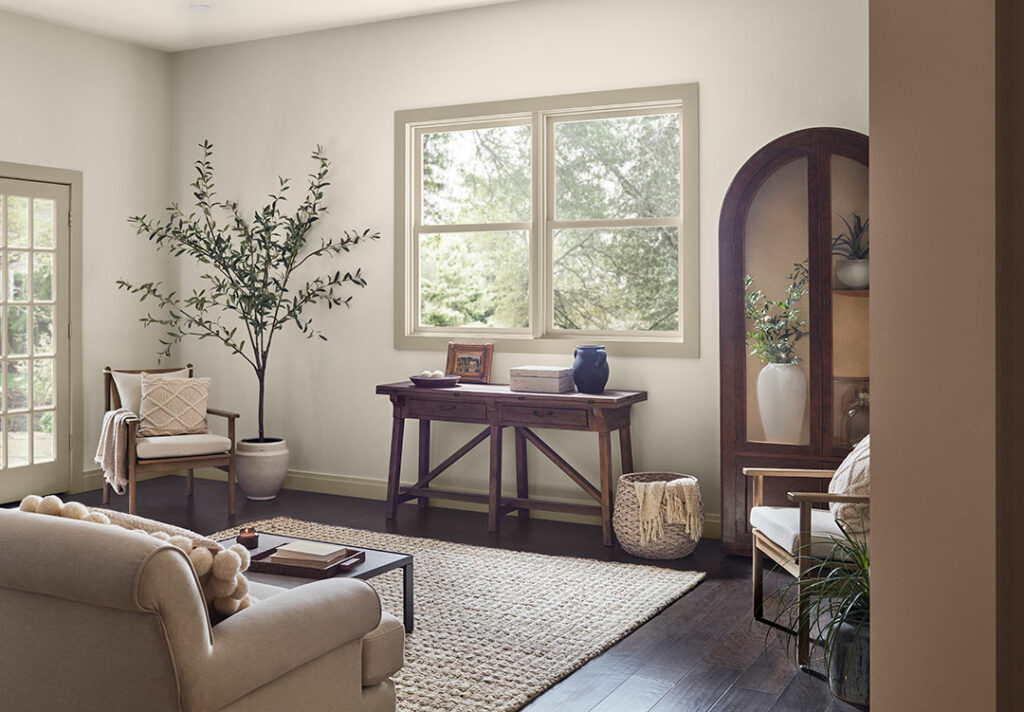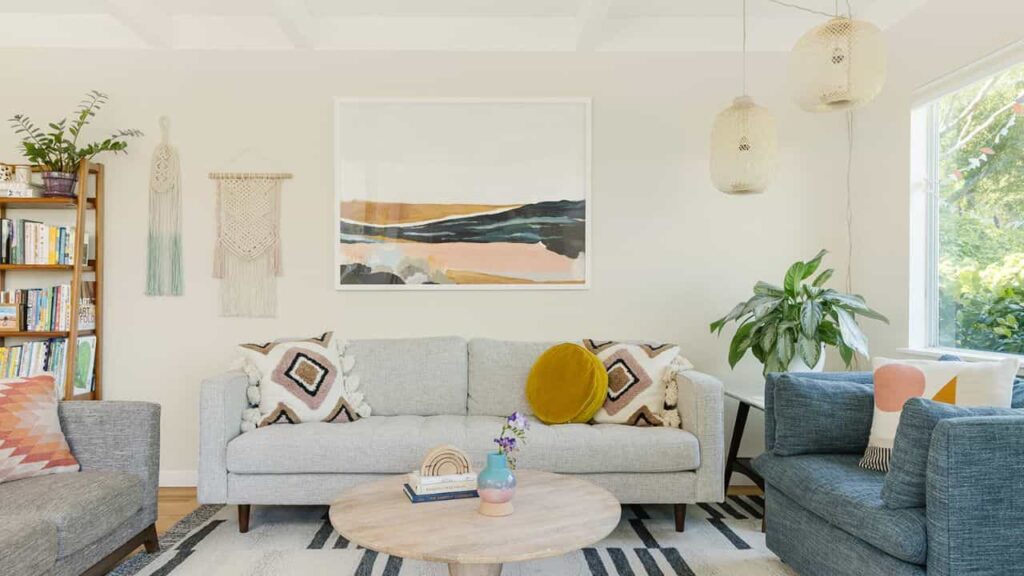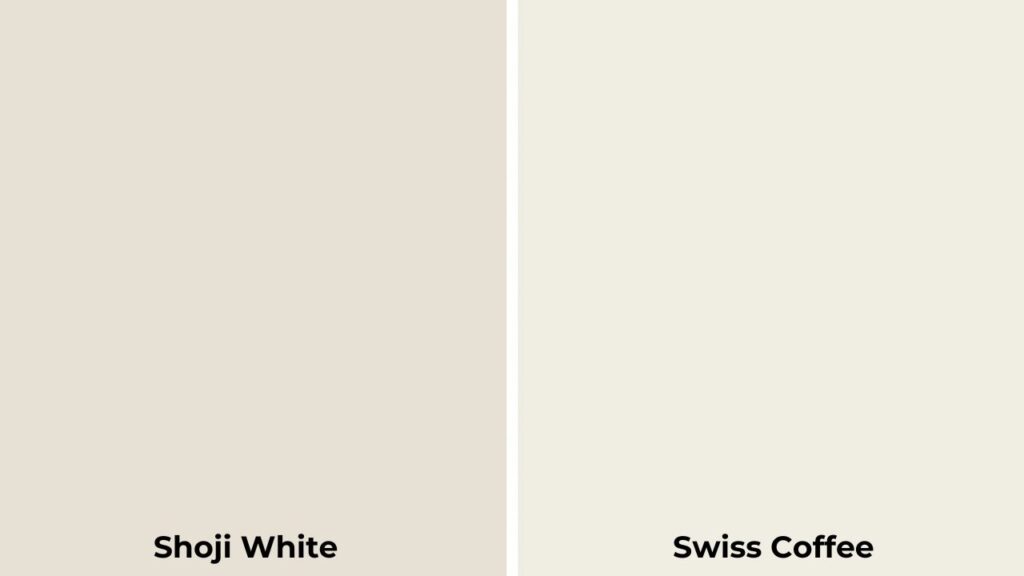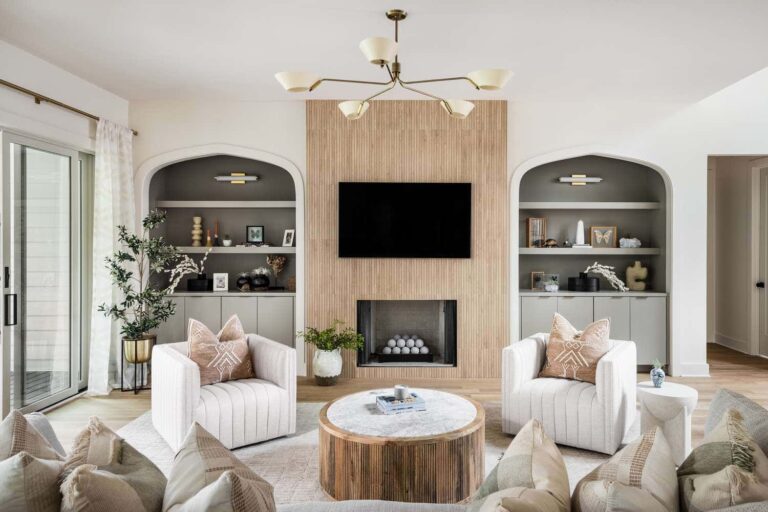When you are looking for a color that is calming and makes your home feel relaxed and lived in, it’s hard to pick one. And, one of the most popular colors are Shoji white and Swiss coffee. But, the question is: Shoji White Vs Swiss Coffee, which one you should choose?
When you put these two colors together, it’s hard to tell which one you should pick. Each of these colors have their own set of charm and value. If you look closely, you will notice these colors have different hues. Sherwin Williams’ Shoji white (SW 7042) and Benjamin Moore’ Swiss Coffee, both colors may look similar but they are not. They have some minor differences.
In this article, we are going to take a closer look at Shoji white vs Swiss coffee, what these two elegant and charming shades have to offer. Plus, we will see which one should choose for your room makeover.
Understanding the basics of Shoji White and Swiss Coffee
Understanding a color doesn’t have to be complicated, in this section, we are going to break down these two colors to help you understand their essence and how they can transform a space.
What is Shoji White?

Shoji white from Sherwin Williams, is a warm, creamy off-white color with a hint of grey-beige undertones. Since it has beige in its undertones, it is often categorised as a greige paint color. This color is the perfect choice for those who want a cozy yet modern vibe in their homes without making their space too plain or boring by using white.
Shoji White is a versatile color that can be used for both interior and exterior projects, giving your home a friendly and inviting vibe all while maintaining a chic appearance. This color pairs amazingly with natural materials like wood, stone, and neutral fabrics, giving spaces a soft yet sophisticated touch.
So, if you want something modern, minimalist, and transitional, you can go for this color and bring a sense of calm and balance to your space. It can be used as both the main wall or as an accent wall color. Its understated warmth makes it an ideal choice for those rooms that may lack natural light, creating a clean, contemporary aesthetic.
What is Swiss Coffee?

Swiss coffee from Benjamin Moore, is a creamy white color with soft yellow undertones. This color has the perfect balance of warmth and comfort, making it a perfect option for those who want to create a traditional, vintage-inspired space in their homes.
Swiss coffee works beautifully for those spaces that want to achieve a warm, lived in look. To enhance its beauty, you can pair it with warm wood tones like cedar, antique accents, or earthy tones.
It’s a versatile color that blends seamlessly and adds a touch of timeless elegance. It’s a popular choice for creating a welcoming atmosphere in your living rooms, kitchens, or even bedrooms. It’s mostly used for painting interior walls, trim, and cabinetry. Swiss Coffee has a lighter shade in comparison to shoji white, which means it can make spaces feel more bright, providing a clean and classic feel to it.
It’s no doubt that both Shoji White and Swiss Coffee are beautiful in their own ways, but their differences is what makes them unique. They can suit different styles and spaces beautifully. Now that we have understood their basics, you might be able to decide which one aligns best with what you have in mind.
Shoji White vs Swiss Coffee: An In depth Review

Now that we have understood the basics of Shoji White and Swiss Coffee, it’s time to dive deeper into how these two colors do against each other in different areas. Both of these shades have their own charm, but by understanding their differences and doing comparison, you can decide which one suits your space and vision the best. From undertones to their application, we will see which one comes closer to the aesthetic you have in mind.
Undertones and warmth
The biggest difference between shoji white and swiss coffee lies in their undertones. Shoji White has a subtle gray-beige undertone which gives it a soft, neutral warmth with a modern edge. Plus this color has beige in its undertone making it fall in the greige color category. It’s quite versatile and works in almost every setting without feeling too stiff or yellow.
Swiss Coffee on the other hand, has more yellow undertones, which gives it a creamy and soft look. This shade brings a sense of warmth and coziness, perfect for creating a traditional or vintage feel in your home. However, due to its yellow undertones, it appears brighter than Shoji White, so it’s ideal for those spaces that don’t get much natural light.
We would suggest you do a patch test first to see which color suits your space the best. While both colors have warm undertones, they have significant differences. If you prefer something modern with neutral and subtle warmth, Shoji white is a great choice. But if you want something traditional that feels cozier and welcoming, then Swiss Coffee is the best choice.
Lighting Consideration (LRV)
Checking the LRV of these two colors is also an important part to see how much light they absorb and reflect. Both shades have different LRV (Light Reflective Value) so let’s do the comparison then. Shoji White has an LRV of 74 which means it reflects a decent amount of light without being too bright. It’s suitable for both well-lit and slightly dim spaces, maintaining its soft, balanced appearance.
While Swiss Coffee has an LRV of 83, which is higher than Shoji White, which means it reflects more light and can make your space feel airy and brighter. It’s ideal for spaces that don’t get much natural light. It can make those spaces feel lighter and open, but rooms with a good amount of lighting can feel brighter than needed.
Take this pro tip, consider the lighting in your room before you choose a shade. If your room lacks natural light, Swiss Coffee can make it bright and cozy. But if your space has balanced or good lighting, Shoji white will be an excellent choice.
Versatility and style Compatibility
When it comes to versatility, both shades are quite excellent. Shoji white’s neutral undertones make it quite versatile, making it ideal for modern, minimalist, or transitional spaces. It pairs well with wood, metal accents, and other neutral colors. You can use this shade to blend traditional and contemporary elements together, creating a stunning yet cozy space.
Whereas Swiss coffee shines in traditional, vintage-inspired spaces. Its soft creamy tones enhance the soft fabrics, antique furniture, and rustic elements. Swiss coffee compliments earthy and warm tones quite well.
Both shades work great in various settings, but their undertones and warmth is what makes them different from each other. To see which colors suit your space and aesthetic style, consider what type of house style you have, its interior decor, and all. Shoji white is suitable for clean, modern spaces, while Swiss coffee is perfect for cozy, traditional spaces.
Application
Both Shoji white and swiss coffee are easy to apply. Shoji white when applied on walls, creates a subtle, muted backdrop that blends effortlessly with the modern spaces. It creates a sense of cohesiveness and calmness, making it ideal for walls, trim, or even cabinets. It’s perfect for blending contemporary with the modern seamlessly.
As for swiss coffee, it has a creamy richness when it is applied which adds depth to walls. Ideal for creating a cozy and welcoming atmosphere. It’s often used in living rooms, kitchens, or bedrooms, also perfect for a space that doesn’t get much natural light. To enhance the look, you can pair it with creamy trims, this will create a layered look in your home.
In short, shoji white’s greige tone makes it suitable for modern and chic designs, while swiss coffee’ creamy texture is perfect for creating classic and timeless aesthetics.
Advice: you can test both colors by doing large swatches on the walls. Observe how they look throughout the day in different light. This will help you decide which color you should go for.
Cost and availability
Just like any other premium brands Sherwin Williams’ Shoji white is widely available and accessible in their stores. It has a mid-range price point. Similarly, Benjamin Moore’s Swiss coffee is easily accessible and priced the same as other premium paint brands.
Moreover, variations of Swiss coffee are available by other brands as well, so this can provide you with budget-friendly options.
But if you are tight on budget and need these shades, you can ask other brands if they offer color-matching services. They can replicate these shades at a lower price.
Best pairing
Now when it comes to pairing these two charming shades, it might be a bit confusing but we are here to help. If you pick shoji white, it pairs well with cooler tones, soft greens, and natural wood tones. It’s perfect for creating a balanced and harmonious look in your space.
As for swiss coffee, it works beautifully with warm beige, wood tones, and vintage-inspired decor, making spaces feel cozy and welcoming.
Here’s a styling tip! Use Shoji white for a modern, clean aesthetic, and Swiss Coffee for a warm, nostalgic feeling.
Tips for choosing between Shoji White and Swiss Coffee
Choosing between Shoji white and swiss coffee can be quite tricky, especially since they are both so appealing. But don’t fret because we have got some practical tips for you, to help choose between Shoji white and swiss coffee. By using these tips, you can select the shade that fits your space, style, and aesthetic preferences.
Consider the natural lighting
Lighting plays a huge role in how a paint color can appear in your space. If your room gets lots of natural light, Shoji white’s soft neutral gray-beige tones can create a soft, balanced feel.
While for rooms with limited natural light, Swiss coffee’s creamy soft yellow undertones can brighten up the space, giving it a warm, cozy feel.
Since Swiss coffee have higher LRV, it can be used to enhance the lighting in low-light rooms, while Shoji White might lean slightly towards soft, and neutral tones.
Match it with your existing decor
See if it matches with your existing furniture, flooring, and accents in your space. Shoji White pairs wonderfully with modern, minimalist furniture or neutral tones that include metals and wood. While on the other hand, Swiss Coffee, with its cozy creaminess, is perfect for spaces with warm woods, vintage inspired pieces, or earthy tones.
Take a moment to think which color suits your space the best. See which paint color can enhance your furniture pieces and bring the whole room together.
Think about your personal style
Let’s not forget, the ultimate goal of picking a color is to get one that reflects your personal style and unique personality. Think about what kind of atmosphere you are going for, if you love clean, modern vibes, then shoji white is perfect. If you love a warm, cozy, and nostalgic vibe then Swiss coffee could be your perfect color.
Just go with what you find most drawn to and that shade is most likely the right one for you.
Conclusion
So. in this Shoji white vs Swiss coffee post, which one won? The answer to that solely depends on what your unique style and vibe is. Choosing the right color is a decision that should be taken after thinking carefully. So take your time, do some sampling, testing, and visualise how the color will look in your space.
Both Shoji white and swiss coffee are excellent shades that can enhance the warmth and brightness of any space. By considering the lighting, decor, and aesthetic in your space, you can choose the one that just feels right in your space. They are both quite similar but have significant differences, like their undertones and the amount of light they aboard and reflect. To see which color suits best, you can do swatches and observe in different lighting. See how the colors interact with the existing furnishing, that way you will be able to make a final decision.
In the end, Shoji white vs Swiss coffee, choosing between these two might have been hard but after going through the basics, you now have an idea on how these shades can impact your space. Just remember to not rush and enjoy the process. Experiment around with different shades, pair it with other colors and elements, after all it’s all about turning your house into a home that truly feels like yours.

